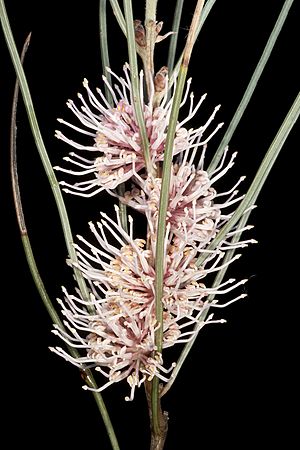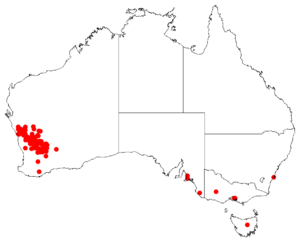Hakea invaginata facts for kids
Quick facts for kids Hakea invaginata |
|
|---|---|
 |
|
| Scientific classification | |
| Genus: |
Hakea
|
| Species: |
invaginata
|
 |
|
| Occurrence data from AVH | |
Hakea invaginata is a type of shrub that belongs to the Proteaceae plant family. It only grows naturally in Western Australia, which means it's endemic there. This plant has pretty purplish-pink flowers and smooth, needle-shaped leaves. Its small branches are also covered in lots of tiny hairs.
What Does Hakea invaginata Look Like?
Hakea invaginata is a shrub that spreads out. It usually grows to be about 1.5 to 3 metres (5 to 10 ft) tall. Unlike some plants, it does not have a special woody base called a lignotuber that helps it regrow after a fire.
Its small branches are thickly covered in fine, tangled hairs. The leaves are always green and shaped like needles. They have five deep, narrow grooves running all along their length. The leaves feel smooth and are not hairy. They can be 7 to 22 centimetres (2.8 to 8.7 in) long and about 1.2 to 1.5 millimetres (0.047 to 0.059 in) wide.
This plant blooms from June to September. It produces beautiful pink-purple flowers. Each group of flowers looks like a long, brush-like structure. These groups have 60 to 80 flowers each. The main part of the flower, called the perianth, is usually pink, but sometimes it can be white. The pistil (the part that receives pollen) is about 10 to 12.5 mm (0.394 to 0.492 in) long.
After the flowers bloom, the plant forms fruits. Each fruit is attached by a stalk. They are shaped like an oval, sometimes a bit curved. They are about 1.6 to 2.2 cm (0.63 to 0.87 in) long and 0.8 to 1.1 cm (0.315 to 0.433 in) wide. Inside the fruits are seeds. These seeds are light to dark brown with some blackish spots. They are shaped like an oval or egg and are about 11 to 14 mm (0.433 to 0.551 in) long and 5 to 6 mm (0.197 to 0.236 in) wide. Each seed has a wing on both sides of its body.
How Was Hakea invaginata Named?
The plant Hakea invaginata was first officially described in 1950. A botanist named Brian Burtt gave it its formal name. He wrote about it in a book called Hooker's Icones Plantarum.
This plant has also been known by a few other names in the past. These older names are Hakea invaginata var. invaginata, Hakea sulcata var. intermedia, and Hakea invaginata var. pachycarpa.
The second part of the plant's scientific name, invaginata, comes from a Latin word. This Latin word means "enclose" or "fold in." This name was chosen because of the plant's leaves, which have deep grooves running along them, making them look like they are folded inward.
Where Does Hakea invaginata Grow?
Hakea invaginata is found only in certain parts of Western Australia. It grows in areas known as the Wheatbelt and Mid West regions. You can find it from places like Northampton, Western Australia in the northwest, all the way to Mount Magnet, Western Australia in the northeast, and down to Merredin, Western Australia in the south.
This shrub prefers to grow in sandy, loamy (a mix of sand, silt, and clay), or gravelly soils. It is often seen on flat, sandy areas called sandplains. Here, it grows as part of shrubland communities. These are areas where many shrubs grow together, often with other plants like Acacia or Melaleuca species.

